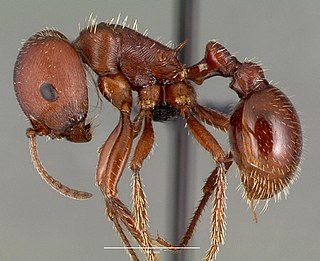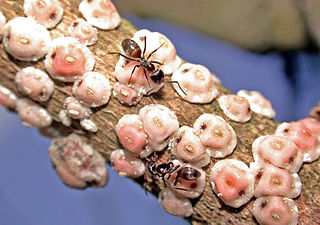
Myrmecology is a branch of entomology focusing on the scientific study of ants. Some early myrmecologists considered ant society as the ideal form of society and sought to find solutions to human problems by studying them. Ants continue to be a model of choice for the study of questions on the evolution of social systems because of their complex and varied forms of eusociality. Their diversity and prominence in ecosystems also has made them important components in the study of biodiversity and conservation. Recently, ant colonies are also studied and modeled for their relevance in machine learning, complex interactive networks, stochasticity of encounter and interaction networks, parallel computing, and other computing fields.

Myrmicinae is a subfamily of ants, with about 140 extant genera; their distribution is cosmopolitan. The pupae lack cocoons. Some species retain a functional sting. The petioles of Myrmicinae consist of two nodes. The nests are permanent and in soil, rotting wood, under stones, or in trees.

Pogonomyrmex is a genus of harvester ants, occurring primarily in the deserts of North, Central, and South America, with a single endemic species from Haiti.

Dorymyrmex is a genus of ants in the subfamily Dolichoderinae.

Crematogaster is an ecologically diverse genus of ants found worldwide, which are characterised by a distinctive heart-shaped gaster (abdomen), which gives them one of their common names, the Saint Valentine ant. Members of this genus are also known as cocktail ants because of their habit of raising their abdomens when alarmed. Most species are arboreal (tree-dwelling). These ants are sometimes known as acrobat ants.

Plagiolepis is an ant genus of the formic acid-producing subfamily Formicinae. The genus is found in tropical and temperate regions of the Old World.

Anochetus is a genus of small, carnivorous ants found in the tropics and subtropics throughout the world.

Hypoponera is a genus of ants in the subfamily Ponerinae. The genus has a worldwide distribution and is found in all continents except Antarctica.

Dolichoderus is a genus of ants found worldwide.

Cyphomyrmex is a genus of fungus-growing ants found primarily in South and Central America. However, some species do come up to the southern portion of North America. They grow a variety of fungi in the tribe Leucocoprineae. Most fungal gardens are grown in small nodules, some species to cultivate entire mycelium, though. Colonies are monogynous and are relatively small with about 100 workers on average.

Gnamptogenys is a genus of ants in the subfamily Ectatomminae. The genus has a wide distribution. It is known to occur in the Nearctic, Neotropic, Indomalayan and Australasian realms.

Typhlomyrmex is a genus of ants in the subfamily Ectatomminae and the sole member of the tribe Typhlomyrmecini. Known from the Neotropics, the genus has a wide distribution. Some species are restricted in range, while for example Typhlomyrmex rogenhoferi is known from southern Mexico to northern Argentina. Little is known about their biology. The genus 'Typhlomyrmex' means 'blind ant'. All species of this genus contains only blind ants.

Carebara is a genus of ants in the subfamily Myrmicinae. It is one of the largest myrmicine genera with more than 200 species distributed worldwide in the tropics and the Afrotropical region. Many of them are very tiny cryptic soil and leaf-litter inhabitants. They nest in rotten wood to which the bark is still adherent in the Afrotropical region, or may be lestobiotic nesting near other ant species. Some species are known to exist parasitically within termite nests. Little is known about the biology of the genus, but they are notable for the vast difference in size between queens and workers.

Myrmelachista is a Neotropical genus of ants in the subfamily Formicinae. The genus is found exclusively in the Neotropical realm. Little is known regarding their biology.













